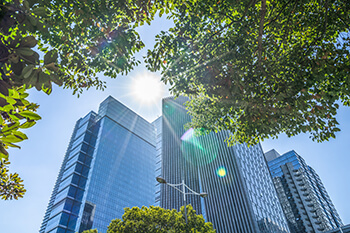
Twenty-first century new construction places an emphasis on environmental concerns. LEED (Leadership in Energy and Environmental Design) certified buildings are intended to use resources more efficiently when compared to conventional buildings simply built to code. In addition to the environmentally-friendly aspects, LEED certified windows and other building materials translate to serious energy savings that pay off in ongoing lower heating and cooling costs. There is, however, a down side to these green, energy efficient buildings: the technology that helps make them green also serves as a barrier to cellular signals. Since cell phones are no longer the exception but are standard equipment for personal and professional needs, cell signals are a necessity in the workplace.
LEED certified materials – like brick, block, steel, concrete and windows that block UV light – also block out RF (radio frequency) signals which are necessary for cell phones to operate. LEED certified windows include layers of metallic coatings and/or inert gases. These serve to block the sun’s rays and stop the transfer of heat. While this is an effective strategy to decrease energy costs, the side effect is that some of those layers and coatings are stopping cellular signals. This is not true of every LEED building and window, but if it’s the reality in your building, you’ve got a problem. You’ve done everything right, you’ve been a steward to the environment, but now you’ve got an unforeseen consequence to attend to.
There are several ways to address this green building challenge. The methods vary in cost and equipment requirements. At KTS we find that one of the simplest and most cost-effective solutions does the best job of enhancing cell signals in green buildings: the cellular bi-directional antenna (BDA). BDAs enhance cellular reception in buildings by capturing, amplifying and redirecting the signal. We will design a custom cellular BDA solution to fit your space and your needs and to support business growth and future physical expansion. Read more about BDAs here.
A cellular BDA is comprised of three parts. A nine- to 12-inch antenna mounted on a six-foot mast on the roof of the building, a signal amplifier which is typically housed in an IT or wiring closet inside the building, and internal antennas (dome or panel) – about the size of a smoke detector – which are strategically and discreetly placed throughout the inside of the building to boost the signal. A cellular BDA system will solve the problem, grabbing the signal from outside and distributing it throughout the facility ensuring that everyone on every floor has a reliable, consistent cell signal.
If your green building has left you with the unintended consequence of sketchy cell reliability, KTS can help you establish a solid connection. Contact us today for more information about ways we can improve your cellular reception and to discuss cellular BDAs.

